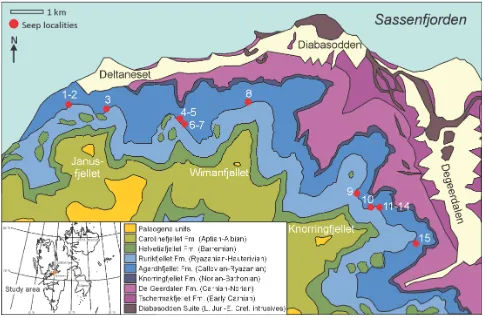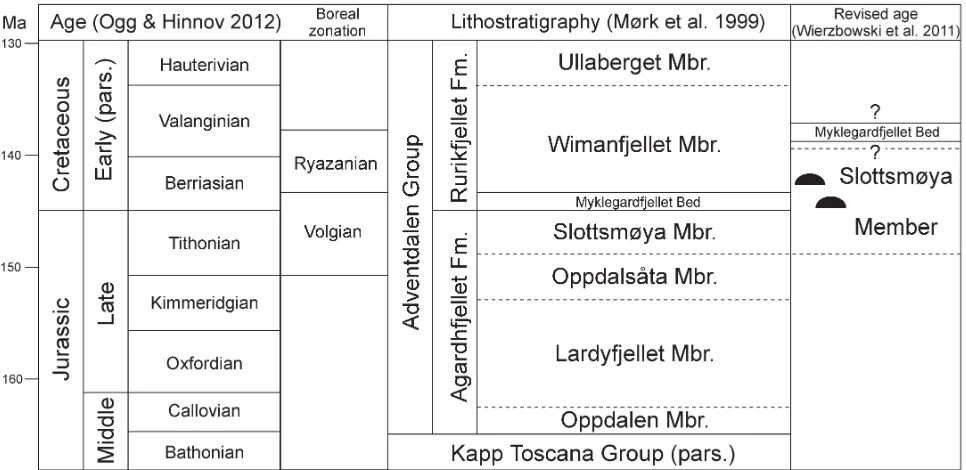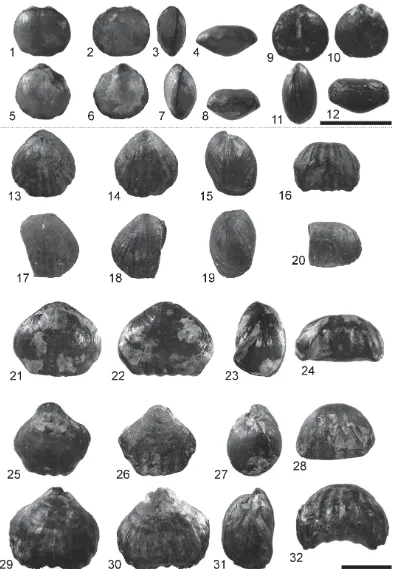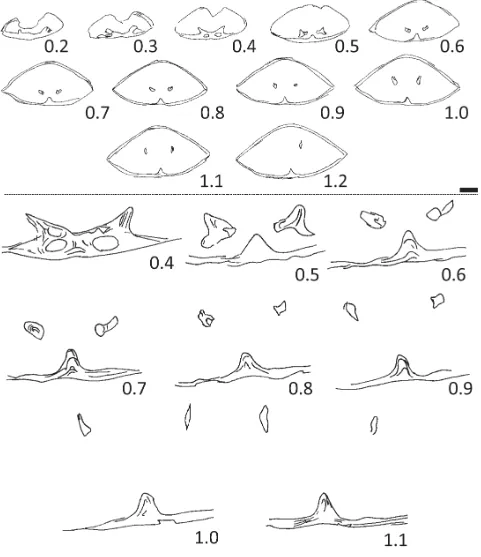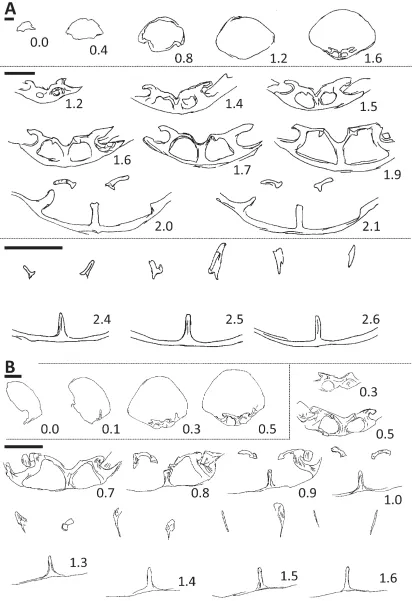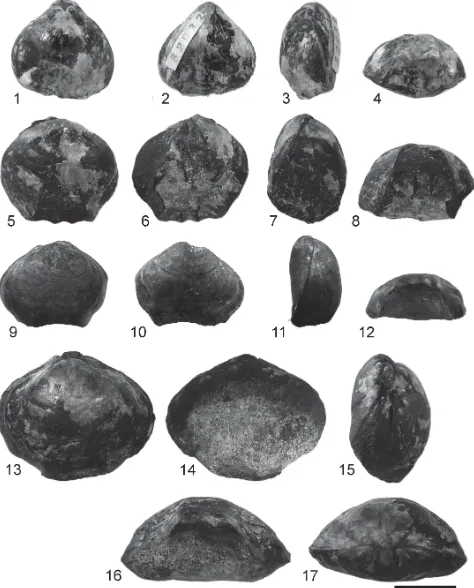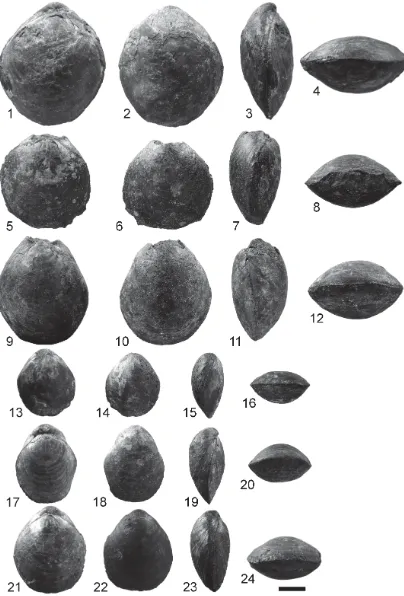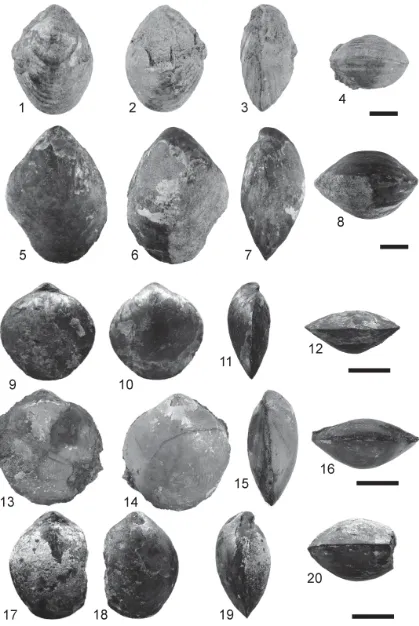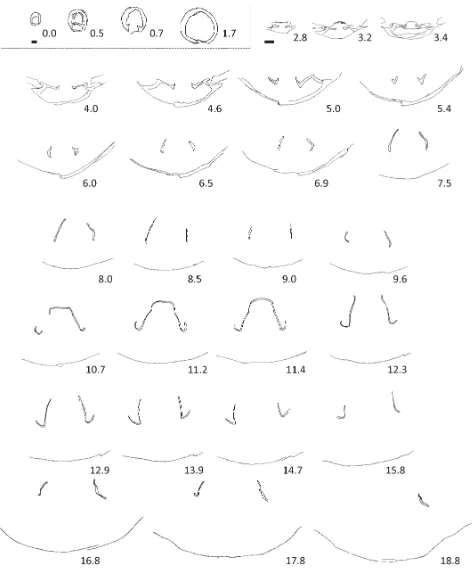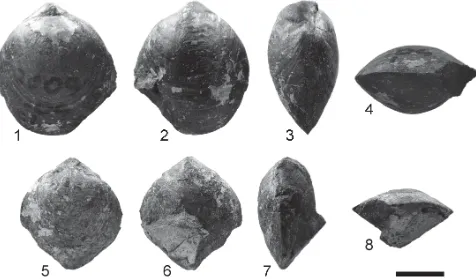ZOOTAXA
ISSN 1175-5326 (print edition)ISSN1175-5334(online edition) Copyright © 2014 Magnolia Press
Zootaxa 3884 (6): 501–532
www.mapress.com/zootaxa/
Article
http://dx.doi.org/10.11646/zootaxa.3884.6.1
http://zoobank.org/urn:lsid:zoobank.org:pub:BD4F285D-358C-4350-88EA-7FA94513D930
Brachiopods from Late Jurassic—Early Cretaceous hydrocarbon seep deposits,
central Spitsbergen, Svalbard
MICHAEL R. SANDY1, KRZYSZTOF HRYNIEWICZ2,3, ØYVIND HAMMER2, HANS ARNE NAKREM2 & CRISPIN T. S. LITTLE4
1Department of Geology, University of Dayton, Dayton, OH 45469-2364, USA. E-mail: msandy1@udayton.edu 2Natural History Museum, University of Oslo, P.O. Box 1172, NO-0318 Oslo, Norway.
E-mails:krzysztof.hryniewicz@nhm.uio.no, oyvind.hammer@nhm.uio.no, h.a.nakrem@nhm.uio.no
3Current address: Institute of Paleobiology, Polish Academy of Sciences, ul. Twarda 51/55, 00-818 Warszawa, Poland.
E-mail: krzyszth@twarda.pan.pl
4School of Earth and Environment, University of Leeds, Leeds LS2 9JT, United Kingdom.
E-mail: earctsl@leeds.ac.uk
Abstract
Late Jurassic–Early Cretaceous (Late Volgian–latest Ryazanian) rhynchonellate brachiopods are described from eight out of 15 hydrocarbon seep deposits in the Slottsmøya Member of the Agardhfjellet Formation in the Janusfjellet to Knor-ringfjellet area, central Spitsbergen, Svalbard. The fauna comprises rhynchonellides, terebratulides (terebratuloids and loboidothyridoids) and a terebratellidine. The rhynchonellides include: Pseudomonticlarella varia Smirnova; Ptilorhyn-chia mclachlani sp. nov.; and Ptilorhynchia obscuricostata Dagys. The terebratulides belong to the terebratuloids: Cyr-tothyris? sp.; Cyrtothyris aff. cyrta (Walker); Praelongithyris? aff. borealis Owen; and the loboidothyridoids: Rouillieria
cf. michalkowii (Fahrenkohl); Rouillieria aff. ovoides (Sowerby); Rouillieria aff. rasile Smirnova; Uralella? cf. jani-maniensis Makridin; Uralella? sp.; Pinaxiothyris campestris? Dagys; Placothyris kegeli? Harper et al.; and Seductorithy-ris septemtrionalis gen. et sp. nov. The terebratellidine Zittelina? sp. is also present. Age determinations for all but one of the brachiopod-bearing seeps are based on associated ammonites. Five of the seep carbonates have yielded Lingularia similis?, and it is the only brachiopod species recorded from two of the seeps. Other benthic invertebrate taxa occurring in the seeps include bivalves, gastropods, echinoderms, sponges, and serpulid and non-serpulid worm tubes. The opod fauna has a strong Boreal palaeobiogeographic signature. Collectively, the Spitsbergen seep rhynchonellate brachi-opods exhibit high species richness and low abundance (<100 specimens from 8 seeps). This contrasts markedly with other Palaeozoic–Mesozoic brachiopod-dominated seep limestones where brachiopods are of low diversity (typically monospecific) with a super-abundance of individuals. The shallow water environmental setting for the Spitsbergen seeps supported a diverse shelf fauna, compared to enigmatic Palaeozoic–Mesozoic brachiopod-dominated seeps.
Key words: Brachiopoda, Rhynchonellida, Terebratulida, hydrocarbon seeps, Jurassic, Cretaceous, Spitsbergen,
Svalbard, new genus, new species
Introduction
Fifteen carbonate bodies interpreted as fossil hydrocarbon seeps (Hammer et al. 2011) were identified during fieldwork (2006–2010) in the Janusfjellet to Knorringfjellet area, Sassenfjorden, central Spitsbergen (Fig. 1). The seeps are hosted by the Slottsmøya Member, which is composed mainly of grey to black organic-rich shales with lesser silty beds and carbonate concretions, and was deposited on the middle-to outer shelf (Nagy et al. 1988; Dypvik et al. 1991; Collignon & Hammer 2012). The strata (Fig. 2) are part of the post-Devonian cover sequence of the Main Spitsbergen Basin (Harland 1997, fig. 3.9).
boundary (e.g. Harland & Kelly in Harland 1997; Abbink et al. 2001; Rogov & Zakharov 2009). They equate roughly to the Tithonian and Berriasian standard stages (e.g. Zakharov & Rogov 2008). The Tithonian–Berriasian and hence the Jurassic–Cretaceous boundary is positioned within the Upper Volgian Taimyrensis zone, so the Lower to lowermost Upper Volgian equates to the Tithonian and the uppermost Volgian and Ryazanian equates with the Berriasian (Houša et al. 2007). This means that all of the Volgian seeps from Spitsbergen are Tithonian and all Ryazanian seeps are Berriasian in age.
[image:2.595.56.541.236.554.2]Collecting from the Sassenfjorden area seeps was not standardized and seeps 1, 2, 3, 8 and 9 were extensively sampled during multiple field seasons, whereas remaining deposits were bulk sampled on a single occasion only. The highest diversity recorded among the brachiopod fauna (at order, genus and species level) is from seep 9 (Table 1; Hammer et al. 2011, table 2). The highly weathered nature of the seep deposits makes it difficult to accurately reconstruct the shape and structure of the original carbonate masses, but they are all less than four metres in width and thickness.
FIGURE 1. Geological map of the Late Jurassic–Early Cretaceous hydrocarbon seep carbonate localities, Spitsbergen (modified from Dallmann et al. 2001), with inset map of Svalbard indicating the study area.
The brachiopod fauna
Eight of the 15 Sassenfjorden area seeps contain rhynchonellate brachiopods. Each species considered herein is typically represented by 1 to 15 specimens. There are at least 12 taxa present among the 80 specimens (Table 1) represented by complete, damaged, or fragmentary material. In over 50% of the specimens the beak of the ventral valve is damaged or missing. This is unfortunate as it means that the nature (and presence/absence) of some important taxonomic characters, such as the shape of the umbo, beak ridges, pedicle foramen, deltidial plates/ symphytium, and interarea, cannot be ascertained for these specimens. A smaller number of specimens have damaged anterior and/or lateral commissures.
Pseudomonticlarella varia Smirnova, Ptilorhynchia mclachlani sp. nov. and Ptilorhynchia obscuricostata Dagys. Specimens referred to ‘Lacunosella’ (in Hammer et al. 2011, following Owen 1976) are now referred to Ptilorhynchia as a result of having made serial sections that reveal internal structures. Two terebratulide taxa were originally identified in this fauna: ‘Praelongithyris’and ‘Cyrtothyris’ (Hammer et al. 2011). Again, serial sections have now been taken of some terebratulide specimens and assignations emended, with forms referred to the terebratuloids Cyrtothyris? sp., Cyrtothyris aff. cyrta (Walker), Praelongithyris? aff. borealis (Owen) and the loboidothyridoids: Rouillieria cf. michalkowii (Fahrenkohl); Rouillieria aff. ovoides (Sowerby); Rouillieria aff. rasile Smirnova; Uralella? cf. janimaniensis Makridin; Uralella? sp.; Pinaxiothyris campestris? Dagys; Placothyris kegeli? Harper et al.; and Seductorithyris septemtrionalis gen. et sp. nov. A terebratellidine has been referred to Zittelina? sp.
[image:3.595.57.540.343.578.2]The inarticulate brachiopod Lingularia similis? Biernat & Emig was described by Holmer & Nakrem (2012) from seeps 9 and 12, and is also observed in thin sections from seeps 1, 5 and 15 (Hammer et al. 2011). It is the most abundant brachiopod taxon from the Spitsbergen seeps (Table 1). Lingularia has been observed at two seeps that lack other brachiopod taxa (seeps 5 and 15); whereas at seeps 1, 9 and 12 other species are present (Table 1; cf. Hammer et al. 2011, table 2). Prior to the overview by Hammer et al. (2011) only inarticulated Mesozoic brachiopods had been figured and described from Svalbard. These Triassic and Jurassic species were originally referred to Lingula and subsequently to Lingularia by Biernat & Emig (1993). In addition a Jurassic species, Discinisca spitsbergensis Biernat (1995), was described from the Toarcian/Aalenian, Brentskardhaugen Bed of Spitsbergen. It is likely that Lingularia is also represented in the nearby Barents Sea borehole (from undifferentiated Berriasian–Valanginian, Århus et al. 1990).
FIGURE 2. Lithostratigraphic subdivision and age relationships of the Middle Jurassic to Early Cretaceous succession of central Spitsbergen. The black hemispherical symbols indicate the relative position and range of the hydrocarbon seep carbonate bodies discussed in this paper.
Previous studies
and Owen (1973), primarily from Europe, while Smirnova (1984, 1997) also considered broader palaeobiogeographic distributions. Ager provided numerous discussions of Jurassic and Mesozoic brachiopod palaeobiogeography (e.g. 1967, 1971a, 1973; Ager & Sun, 1989). Other works giving an overview of aspects of Mesozoic brachiopod palaeobiogeography include, for example, Sandy (1991), Manceñido & Dagys (1992, in which some Siberian species from Dagys (1968) are discussed and refigured) and Manceñido (2002). The Early Cretaceous brachiopods of East Greenland (Muir-Wood 1953; Owen 1976) are of a slightly younger age (Valanginian–Albian(?); Harper et al. 2005) than those from Spitsbergen (Volgian–Ryazanian).
The brachiopod fauna from Svalbard described herein was initially identified in a preliminary survey of the invertebrate fauna from the seep carbonates (Hammer et al. 2011) prior to detailed ammonite age-assignations being available for the majority of the seeps (Wierzbowski et al. 2011).
Palaeobiogeographic considerations
The brachiopod seep fauna from Spitsbergen reveals strong Boreal affinities, including the genera Pseudomonticlarella Smirnova, Ptilorhynchia Crickmay, Rouillieria Makridin, and Uralella Makridin that have been described from the Russian Platform (Makridin 1964; Smirnova 1987); all of these, except Pseudomonticlarella, are also known from northern Siberia (Dagys 1968). Rouillieria and Uralella have also been recorded from northern Europe (e.g. Ager 1971b; Middlemiss 1976). The forms referred to Cyrtothyris and Praelongithyris in the Spitsbergen seep fauna are representative of taxa more broadly distributed throughout lower latitudes, having both been recorded from northern Europe (Middlemiss 1959, 1976, 1979) and South Africa (Owen 1980; northern Zululand); however the assignations to these genera in Spitsbergen are tentative. As it is only known from Spitsbergen the new genus, Seductorithyris, does not add any palaeobiogeographic links and can be considered an endemic element to the fauna. Ptilorhynchia is a component of Boreal faunas, but also appears to have had a broad latitudinal distribution and has even been considered bipolar or cosmopolitan (Thomson & Owen 1979; Århus et al. 1990; Sandy 1991) and more recently as circum-Pacific (Manceñido 2002; MacFarlan et al. 2011). Ptilorhynchia mclachlani sp. nov. also implies a component of endemicity at the species level, but is part of an evolving plexus of closely-related Ptilorhynchia species and does not necessarily imply strong endemicity.
Smirnova (1975) commented that among the terebratulides, the Loboidothyridoidea (with long flanges on the brachidium and complex loop ontogeny) are widely distributed in the Boreal and Tethyan Realms in the Late Jurassic; Makridin (1964) also noted that the terebratulides with a short simple-loop (Terebratuloidea) occupied a subordinate position in Boreal faunas. The Loboidothyridoidea were considered to become extinct in Tethys in the Tithonian (Smirnova 1975) and subsequently the Terebratuloidea are exclusively present in the Tethyan Lower Cretaceous. Early Cretaceous Boreal terebratulides were somewhat delayed in their development compared to Tethyan faunas (Smirnova 1975). This presumably applies to the Terebratuloidea as the Loboidothyridoidea are well-represented in Late Jurassic–Early Cretaceous faunas with Boreal affinities (Makridin 1964; Dagys 1968); in addition, subsequent work has not identified any terebratuloids in the Lower Cretaceous of the Russian Platform (Smirnova 1975, 1987). The composition of the Volgian (Ager 1971b; Smirnova, 1997) and Neocomian (Owen 1965; Smirnova 1997) brachiopod faunas of the Russian Platform and Western Europe (specifically eastern England and northern Germany) point to marine connections between these two areas. In addition, brachiopod faunal components indicate marine connections between the Russian Platform and the Arctic basin of Siberia in the Valanginian (Smirnova 1997).
(fig. 3 in Harper et al. 2005; exterior of sectioned specimen figured herein, Fig. 13.9–13.12). Placothyris is now considered a loboidothyridoid (Lee et al. 2006). So palaeobiogeographic patterns are likely to be more complicated than previously considered.
Palaeoecology
In addition to brachiopods from the Sassenfjorden area the hydrocarbon seeps contain a high diversity of bivalves (17 species, Hryniewicz et al. 2014), gastropods (~10 species; unpublished data) and serpulids (four species; Vinn et al. in press). This makes the Spitsbergen seep faunas very different from many of the Palaeozoic–Mesozoic seep deposits that contain shell beds or lenses dominated by monospecific accumulations of brachiopods (e.g. Campbell & Bottjer 1995; Sandy 1995, 2010; Sandy et al. 2012; Peckmann et al. 2007, 2011, 2013; Kiel & Peckmann 2008). Clearly the overall taxonomic diversity of the Spitsbergen seep communities is much greater and the brachiopod species richness is higher too (Table 1; Hammer et al. 2011, table 2; cf. Sandy 2010, table 9.1). In contrast to these Palaeozoic–Mesozoic brachiopod-dominated seeps the Spitsbergen seep brachiopods are not abundant and are represented by dispersed specimens.
The occurrence of brachiopods in the Spitsbergen seep deposits and not in the surrounding shales can be explained by the early cementation of sediment (Hammer et al. 2011; Hryniewicz et al. 2012) providing suitable hardgrounds for brachiopod pedicle attachment (Campbell 2006; Sandy 2010), as would other shells. These substrates lead to the development of oases (or refuges) on the otherwise clay-dominated substrate of the encompassing Barents Shelf, which would have been further fuelled by the enhanced food availability in the seep environment compared to the surrounding substrate (Hammer et al. 2011). The shelf setting of the Spitsbergen seep deposits contrasts with the Palaeozoic–Mesozoic brachiopod-dominated seep deposits which occur in marine basins in regions of compressive tectonics (e.g. Peckmann et al. 2011, 2013), or basin slope-environments (Sandy et al. 2012). The apparent paucity of invertebrate diversity in brachiopod-dominated seep carbonates contrasts with the higher taxonomic diversity in the Spitsbergen seep deposits, presumably as a result of the shallower shelf water-depths of the latter.
The occurrence of Lingularia in the Slottsmøya Member is the first record of an inarticulated brachiopod from hydrocarbon seeps (Hammer et al. 2011). Lingulids are common in very shallow water Valanginian sediments on East Greenland and are believed to be shallow water indicators (Scott 1970; Plaziat et al. 1978; Fürsich 1984; Emig 1986).
Methods
Serial sections were taken of a few specimens to investigate internal structures. The technique used was that described by Sandy (1989). Infilling sparry calcite and silicification makes it difficult to trace internal structures such as the descending branches of the brachidium in the terebratulides and anterior projecting crura in the rhynchonellides. However, in some cases the level of detail recorded on acetate peels was of a high quality, and results obtained have aided genus-level assignations of the material. The carbonate matrix infill precluded attempts at micro computed tomography of specimens to investigate their internal structures.
Systematics
Specimens designated with a PMO number are housed in the Palaeontological Collections of the Natural History Museum, University of Oslo, Norway. ? after the specimen number = questionable assignment of specimen to taxon. Other abbreviations used: MGUH = Geological Museum, University of Copenhagen, Denmark; USGS = United States Geological Survey, Mesozoic Collections housed at the Federal Center, Denver, Colorado. Annotations on synonymy lists and taxon names follow Matthews (1973).
Phylum Brachiopoda Duméril, 1806
Subphylum Rhynchonelliformea Williams, Carlson, Brunton, Holmer & Popov, 1996
Class Rhynchonellata Williams, Carlson, Brunton, Holmer & Popov, 1996
Order Rhynchonellida Kuhn, 1949
Superfamily Norelloidea Ager, 1959
Family Norellidae Ager, 1959
Subfamily Praemonticlarellinae Manceñido & Owen, 2002
Genus Pseudomonticlarella Smirnova, 1987
Type species. Pseudomonticlarella varia Smirnova, 1987
Diagnosis. Small, equibiconvex, striate, somewhat ligate; outline variable from rounded-triangular to rounded or pyriform; maximum width at midvalve; 3 to 5 lateral folds or plicae; anterior commissure with lateral folds resembling Monticlarella; ventral sulcus broadly arcuate with trapezoidal linguiform extension; ventral umbo long with pointed and slightly incurved beak; foramen small, hypothyrid. Hinge teeth long, deeply inserted; dental plates subparallel to weakly ventrally divergent; strong socket ridges; elongated hinge plates supported by strong, low septum. From Manceñido et al. 2002, p. 1314.
Discussion. This diagnosis is for the genus established by monotypy. Therefore, it is also the diagnosis for the type species, Pseudomonticlarella varia Smirnova. It does not require emendation in the light of the new Spitsbergen material.
Occurrence. Upper Volgian–Lower (?Upper) Ryazanian.
Pseudomonticlarella varia Smirnova, 1987
(Figs. 3.1–3.12, 4)
1987 Pseudomonticlarella varia new species—Smirnova , p. 33, pl. 4, figs. 1, 2, 5–7, text-fig. 1. 2002 Pseudomonticlarella varia Smirnova—Manceñido et al., p. 1314, fig. 891.3a–3p.
Material and occurrence. Seep 7 (PMO 227.419), seep 13 (PMO 227.416–418), seep 10 [damaged specimen, anterior commissure not present, PMO 224.923?].
Description. Small (less than 1 cm in length, width, and thickness), smooth rhynchonellide that shows traces of capillate ornament in places. However, the decortication of specimens makes it difficult to verify the ornament of the shell exterior. The anterior commissure is bisulcate with weakly developed sulcii at the commissure; central sulcus shallower than lateral sulcii.
FIGURE 4. Transverse serial sections of Pseudomonticlarella varia Smirnova, seep 13, PMO 227.416. Sections 0.4–1.1 mm given at higher magnification below dotted black line. Serial sections prepared perpendicular to maximum length of the specimen, numbering of sections starts at 0.0 mm the initial section through the specimen. Dimensions of sectioned specimen: L 7.0+; W 8.1; T 4.1 mm (+ = dimension damaged/specimen broken in that direction). Scale bars = 1 mm.
Discussion. The general outline and profile of the specimens from Spitsbergen are similar to those of specimens figured by Smirnova (1987, pl. 4, figs. 1–2) from the Russian Platform, in particular that in pl. 4, fig. 1. This specimen appears to be smooth, developing costae at the anterior margin. The Russian Platform specimens reach maximum lengths close to 6 mm (Smirnova 1987, p. 42) so are smaller than the Spitsbergen material that reach 8 mm in length.
Smirnova provided serial sections of two specimens of Pseudomonticlarella varia (1987, fig. 1a–b). Both series of sections show a septalium and crura that arch ventrally anteriorly. These are features that are shared with the Spitsbergen specimen (Fig. 4). The internal structures (from the initial section through the brachiopod) were traced for 4.12 mm in specimen No. 139/584 (Smirnova 1987, fig. 1a) and for 1.45 mm in specimen No. 139/590 (fig. 1b). In the Spitsbergen specimen the internal structures were traced to section 1.2 mm (i.e., 1.2 mm from the initial section through the specimen).
It was thought originally that these diminutive specimens could be juveniles of the form referred herein to Ptilorhynchia mclachlani sp. nov. However, posteriorly the ventral valve of Pseudomonticlarella varia lacks any developing or incipient costae, which are often present posteriorly on specimens of Ptilorhynchia mclachlani. Also, posteriorly, the dorsal valve of Pseudomonticlarella varia is weakly sulcate (possibly enhanced by some decortication). This sulcate condition does not appear to characterize specimens of Ptilorhynchia mclachlani. In addition, Ptilorhynchia mclachlani and Pseudomonticlarella varia are not occuring. Obviously they should co-occur if they are conspecific (although this could reflect a collecting failure). The specimens of Pseudomonticlarella varia all occur with similar maximum dimensions and there are currently no other intermediate-sized forms between these and larger-sized species such as Ptilorhynchia mclachlani.
Stratigraphic and geographic distribution. Upper Volgian–Lower (?Upper) Ryazanian of Spitsbergen and originally described from the Upper Volgian of the Russian Platform (Smirnova 1987).
Superfamily Rhynchonelloidea d’Orbigny, 1847
Family Rhynchonellidae d’Orbigny, 1847
Subfamily Piarorhynchiinae Shi & Grant, 1993
Genus Ptilorhynchia Crickmay, 1933
Type species. Ptilorhynchia plumasensis Crickmay, 1933
Ptilorhynchia mclachlani sp. nov.
Figs. 3.13–3.32, 5
2011 v. partim ‘Lacunosella’ sp.—Hammer et al., p. 21, table 2, fig. 7R. 2011 v. partim ‘Monticlarella’ sp.—Hammer et al., p. 21, table 2.
Material and occurrence. Holotype: PMO 224.882; paratypes: PMO 227.431, PMO 227.432, PMO 224.871–873, PMO 224.875, PMO 224.883, PMO 217.199, PMO 224.914 (crushed). Juvenile specimens: PMO 224.876–879, PMO 227.433. All specimens from seep 9.
Type locality. Knorringfjellet, central Spitsbergen, N78° 18’ 49.9” E16° 10’ 58.9”.
Etymology. For the late Mr. Archie McLachlan, Department of Geology, Queen Mary College, University of London (see Middlemiss 1997, p. 169).
Dimensions of the holotype. PMO 224.882—Length 17.1 mm, width 18.9 mm, thickness 11.6 mm.
Crura develop at top of Y-shape of septalium, where inner and outer hinge plates meet. Anteriorly crura arch ventrally.
Discussion. The beak of the ventral valve is frequently damaged/incomplete in the specimens. As a result, the dental lamellae are usually clearly visible in the umbo of the ventral valve. Juvenile specimens have costae developed over both valves, some larger specimens have costae developed primarily in the sulcus of the ventral valve and at the anterior margin.
The material from Spitsbergen shows variability in outline and number of costae. The costae are traceable over most of the length of the valves. Owen (1972) described a variable species that he referred to Ptilorhynchia jeletzkyi from the latest Jurassic of British Columbia which is very similar to the material from Spitsbergen.
Owen (1972, p. 2) comments on Ptilorhynchia jeletzkyi “The shell surface is smooth, exhibiting no sign of striae, but often developing strong marginal plicae which originate midway between the umbones and anterior commissure. These plicae number from one to four . . .”. However, these strong plicae are not obvious in figured specimens (Owen 1972, pl. 1, figs. 1–4) or a specimen referred herein to Ptilorhynchia jeletzkyi from the Upper Jurassic (Kimmeridgian–Tithonian?) of Alaska (Fig. 6.5–6.8). This specimen is slightly damaged at the anterior commissure and the lateral margin, but does show the generally smooth shell ornament and the development of marginal costae (3 costae on the dorsal fold, 2 in the ventral sulcus). The number of costae in the sulcus (at the anterior commissure) in Ptilorhynchia jeletzkyi ranges from one to 4 or 5 (Owen 1972, fig. 4, pl. 1, figs. 1c, 2–4). Ptilorhynchia jeletzkyi is reported from the Buchia fisheriana and B. piochii zones (i.e., Upper Tithonian, in part equivalent to the Upper Volgian).
In Ptilorhynchia mclachlani, the specimens may show well-marked costae which may extend across most of the length of the specimen (e.g. Fig. 3.29). This costate shell ornament is not typical of Ptilorhynchia, which tends to show costation developed at the shell margin (e.g. species figured by Dagys 1968; Owen 1972; Owen & Manceñido 2002; and P. jeletzkyi herein, Fig. 6.5–6.8, and a specimen identified as P. aff. plumasensis from the Middle Jurassic of Alaska, Fig. 6.1–6.4 close to the type species from the Middle Jurassic Hinchman Formation (Callovian) of California (Crickmay 1933; see also Owen 1972). MacFarlan et al. (2011) claim the type horizon for P. plumasensis to be the Upper Jurassic Knoxville Formation, but their reason for this revised assignation was not given). Most of the specimens from Spitsbergen display four costae on the dorsal fold and three costae in the ventral sulcus. Due to the distinctive nature of the costation it is considered desirable to refer the Spitsbergen material to a new species rather than to the morphologically similar P. jeletzyki.
The weakly costate Ptilorhynchia mclachlani resembles some species referred to Ptilorhynchia by Dagys (1968). Of these, the Spitsbergen specimens are closest to P. lenaensis in the nature of the costation of the anterior commissure but the overall size of the latter is smaller, and the number of costae on the fold and sulcus fewer than in the Spitsbergen specimens. Matching closely in outline and costation is P. anadyrensis Dagys (1968, pl. 4, figs. 3, 4) although the nature of the costation appears more angular at the anterior commissure when compared to Ptilorhynchia mclachlani. The specimens of these species figured by Dagys appear to all be decorticated. The age assignment of P. lenaensis is Valanginian (Dagys 1968) so it is slightly younger in age than the Spitsbergen specimens while P. anadyrensis was given as of uncertain age, referred questionably to the Bathonian–Callovian (Dagys 1968, table 1, p. 145). A single rhynchonellide specimen (internal cast of a ventral valve, approximately 8 mm x 8 mm) from undifferentiated Berriasian–Valanginian of the Barents Sea (Århus et al. 1990) identified as Ptilorhynchia sp., was tentatively referred to this genus. MacFarlan et al. (2011) described Ptilorhynchia pugnaciformis from the Lower Cretaceous of the Misool Archipelago, eastern Indonesia. Like other species of Ptilorhynchia already discussed, the number of costae for this species is considered to be variable (between 3–6 per valve; MacFarlan et al., table 1). The posterior profile of the dorsal valve in P. pugnaciformis is not as rounded as it is in P. mclachlani or P. jeletzkyi; in pugnaciformis the profile may be cynocephalous and therefore resembling, at least in profile, Homoeorhynchia Buckman.
Manceñido et al. 2002, p. 1316). (From the palaeobiographic point of view, Monticlarella has not been recorded from Boreal faunas of the Russian Platform or Siberia, whereas several species have been referred to Ptilorhynchia from these regions.) Serial sections were taken of one of the smaller-sized specimens of Ptilorhynchia mclachlani to clarify the relationships among the material (Fig. 5B). The serial sections show remnants of a dental lamella on the right side of the specimen (Fig. 5B, section 0.1), a well-developed septalium (0.3–0.7) and crura that arch ventrally towards the anterior of the brachiopod (1.0–1.6). The crura develop as discrete structures at the junction between the outer hinge plates and the inner hinge plates of the septalial structure (0.5–1.0). These serial sections are very similar in overall aspect to those taken from the larger specimen (Fig. 5A) and both are considered Ptilorhynchia mclachlani.
In comparing the serial sections of Ptilorhynchia mclachlani (Fig. 5) with Ptilorhynchia jeletzkyi (Owen 1972, fig. 1) there are similarities in the development of the septalium and the crura on the inner margins of the hinge plates, and the crura then arch ventrally anteriorly. The larger Spitsbergen specimen (Fig. 5A) did not capture the dental lamellae of the ventral valve, and this is also true when comparing the serial sections of species referred to Ptilorhynchia by Dagys (1968). The presence of well-developed dental lamellae in the ventral valves of the Canadian (Owen 1972), Siberian (Dagys 1968) and Indonesian (MacFarlan et al. 2011) material is a difference from the Spitsbergen material. The ventral umbo of the larger specimen selected for serial sectioning (Fig. 3.21–3.24) was damaged, with the outline of dental lamellae visible, and their traces can also be determined in the duplicate cast taken of this specimen. In addition, dental lamellae are clearly visible in the damaged ventral umbones of other specimens. Traces of dental lamellae were not seen in the serial sections and acetate peels (for specimen in Fig. 5A). This specimen was decorticated and the calcite shell of the dental lamellae apparently lost through decortication or weathering in the umbonal region of the ventral valve. Most of the external shell of the specimen was absent too. Of the serial sections of species described by Dagys, P. lenaensis Dagys (1968, fig. 43) and P. anadyrensis Dagys (1968, fig. 39) appear closest to those of Ptilorhynchia mclachlani (Fig. 5) based on the development of the septalium, hinge plates, and derivation of the crura from the inner margins of the hinge plates. It should be noted that plates 2 and 5 in Dagys 1968 were printed in the wrong order. The taxonomic descriptions and caption for plate 5 refers to P. glabra, P. lenaensis and P. obscuricostata. However, these species are figured on plate 2.
Serial sections of the Spitsbergen material (Fig. 5) lack the falciform crura characteristic of the genus Lacunosella recorded from Greenland (Owen 1976, fig. 3).
Stratigraphic and geographic distribution. Upper Ryazanian of Spitsbergen.
Ptilorhynchia obscuricostata Dagys, 1968
Fig. 6.9–6.17
1968 Ptilorhynchia obscuricostata new species—Dagys, p. 63, pl. 5, fig. 6, 7, text-fig. 42. 2011 v. partim ‘Lacunosella’ sp.—Hammer et al., p. 21, table 2.
Material and occurrence. Seep 3 (PMO 224.915), seep 9 (PMO 224.881, PMO 224.880), seep 12 (PMO 224.884).
Description. Wide triangular outline. Biconvex profile. Broad flat-topped uniplication of the anterior
commissure. Smooth shelled with weak or incipient costae developed at the anterior margin, primarily in the fold/ sulcus of the anterior commissure. A few growth lines are present. Median septum and dental lamellae are visible. Other internal structures have not been investigated.
FIGURE 6. 1–4. Ptilorhynchia aff. plumasensis Crickmay, USGS Mesozoic Locality 32032 (=80Ace119), Karluk Quadrangle, Alaska, Shelikof Formation, Callovian, Middle Jurassic, dorsal, ventral, lateral, and anterior views. 5–8. Ptilorhynchia jeletzkyi
lamellae are massively overgrown (Owen 1976, fig. 3). A median septum is present in the dorsal valve of the Spitsbergen material whereas Lacunosella lacks a median septum (e.g. Owen 1976, fig. 3; Manceñido & Owen 2002, p. 1208).
Stratigraphic and geographic distribution. Upper Volgian–uppermost Ryazanian, Spitsbergen and Lower Volgian of northern Siberia (Dagys 1968).
Order Terebratulida Waagen, 1883
Suborder Terebratulidina Waagen, 1883
Superfamily Terebratuloidea Gray, 1840
Family Sellithyrididae Muir-Wood, 1965
Subfamily Rectithyridinae Muir-Wood, 1965
Genus Cyrtothyris Middlemiss, 1959
Type species. Terebratula depressa var. cyrta Walker, 1868
Cyrtothyris? sp.
Fig. 7.5–7.8
1976 ? v. “Cyrtothyris” maynci new species—Owen, p. 13, pl. 2, fig. 1a–c, pl. 3, fig. 4a–c, text-fig. 7. 2011 v. partim ‘Cyrtothyris’ sp.—Hammer et al., p. 20, table 2.
Material and occurrence. Seep 3 (PMO 224.870, PMO 224.904?, PMO 224.919?), seep 8 (PMO 227.428?). Description. Rounded, circular, to gently elongate outline, equibiconvex lateral profile, rectimarginate anterior commissure.
Discussion. The material from Spitsbergen reaches larger maximum dimensions than “Cyrtothyris” maynci
described from Greenland (Owen 1976). Broken ventral umbones hamper identification (e.g. Fig. 7.5–7.8) and referral to Cyrtothyris must be considered tentative. Owen commented that the Greenland form has an incipient uniplicate anterior commissure. The Spitsbergen specimens show a rectimarginate anterior commissure to possibly weakly uniplicate (Fig. 7.8, anterior commissure damaged). The Greenland material is from the Falskebugt Member (Harper et al. 2005) of Valanginian age whereas the Spitsbergen specimens are from the Upper Volgian. Cyrtothyris has not been recorded from the Upper Jurassic and these specimens may represent a new form.
Some of the Spitsbergen brachiopods are morphologically close to Cyrtothyris and Rouillieria. Species referred to these two genera may be morphologically very similar and details of the ventral umbo and profile can be important in distinguishing between them (as discussed by Middlemiss 1976). Several specimens from seep 9 are now considered to be Seductorithyris septemtrionalis; these have an erect beak and lack the produced ventral beak of Cyrtothyris, and are typically less inflated in profile than the latter. However, one specimen from seep 9 (Fig. 7.1–7.4; PMO 224.895) with a suberect ventral umbo and incipiently uniplicate anterior commissure, is referred to Cyrtothyris aff. cyrta (Walker). Middlemiss (1976) considers that this species has a rectimarginate to uniplicate anterior commissure.
Stratigraphic and geographic distribution. Upper Volgian of Spitsbergen.
Genus Praelongithyris Middlemiss 1959
FIGURE 7. 1–4. Cyrtothyris aff. cyrta (Walker).PMO 224.895, seep 9, dorsal, ventral, lateral, and anterior views. 5–8.
Praelongithyris? aff. borealis Owen, 1976
Fig. 7.9–7.20
1976 v. aff. “Praelongithyris” borealis new species—Owen, p. 11, pl. 2, fig. 2, text-fig. 6. 2011 v. ‘Praelongithyris’ sp.—Hammer et al., p. 20, table 2.
Material and occurrence. Seep 1 (PMO 224.886?, PMO 224.912, PMO 224.907, PMO 224.908?), seep 9 (PMO 227.424–425, PMO 224.888–890, PMO 224.898), seep 12 (PMO 224.887?, PMO 224.935–936).
Description. Elongate rounded to sub-pentagonal outline with dorsal valve longer than wide, evenly biconvex profile with dorsal valve flatter, euseptoidum present, elongate adductor muscle scars. Rounded beak ridges. Lateral commissure gently arched, anterior commissure rectimarginate to incipiently or broadly uniplicate.
Discussion. The elongate outline and biconvex profile are comparable to “Praelongithyris” borealis Owen. As
with Cyrtothyris discussed above, the Spitsbergen specimens reach larger dimensions than the material from Greenland. A uniplicate specimen with an elongate-oval outline (Fig. 7.17–7.20) resembles Moutonithyris moutoniana (d’Orbigny). A juvenile specimen (Fig. 7.13–7.16) is similar in outline to Cyrtothyris cyrta (Middlemiss 1976, pl. 7, fig. 5) although the profile of the latter has a less inflated dorsal valve; however, the generalized rounded outline is typical for juveniles of many terebratulide species.
Praelongithyris? aff. borealis is similar in outline to Taimyrothyris kropotkini (Moisseiev) figured by Dagys (1968, pl. 23, fig. 3). The material recorded by Dagys reaches larger maximum dimensions than the largest Spitsbergen specimen, being L 48; W 34; T 29 mm (Dagys 1968, p. 128) and is more inflated in profile. It is difficult to be certain as to the affinities of the Spitsbergen material without the aid of details of internal structures. However the Spitsbergen specimens, where decorticated, show no trace of crural plates (that would be expected) adjoining the floor of the dorsal valve, typical of the Boreiothyrididae (as in Taimyrothyris, Dagys 1968, fig. 76) and it is concluded that the material is not referable to Taimyrothyris. Dagys recorded Taimyrothyris kropotkini from the Lower Volgian and questionably from the Callovian–Oxfordian. Owen (1976) recorded “Praelongithyris” borealis from the Valanginian of Falskebugt, Wollaston Forland, East Greenland. The Spitsbergen material comes from the Upper Ryazanian.
Stratigraphic and geographic distribution. Upper Ryazanian of Spitsbergen.
Superfamily Loboidothyridoidea Makridin, 1964
Family Lissajousithyrididae Cooper, 1983
Subfamily Lissajousithyridinae Cooper, 1983
Genus Rouillieria Makridin, 1960
Type species. Terebratula michalkowii Fahrenkohl, 1856
Rouillieria cf. michalkowii (Fahrenkohl)
Figs. 7.21–7.24, 8.1–8.8, 9
1964 cf. Rouillieria michalkowii (Fahrenkohl)—Makridin, p. 249, text-figs. 83, 84, pl. XVI, figs. 7, 8, pl. XVII, figs. 1–3. 2011 v. partim ‘Praelongithyris’ sp.—Hammer et al., p. 20, table 2.
Material and occurrence. Seep 8 (PMO 227.420, PMO 224.925?, PMO 224.927, PMO 224.930?), seep 13 (PMO 227.421–423, PMO 224.901–902, PMO 224.905).
Description. Elongate-oval to subtriangular to subpentagonal outline, evenly biconvex profile. Lateral
commissure straight to gently ventrally arched. Broad, weak uniplication of the anterior commissure.
FIGURE 8. 1–8. Rouillieria cf. michalkowii (Fahrenkohl). 1–4. PMO 227.422, seep 13, dorsal, ventral, lateral, and anterior views. 5–8. PMO 227.420, seep 8, dorsal, ventral, lateral, and anterior views. Specimen serially sectioned (Figure 9). 9–16.
FIGURE 9. Transverse serial sections of Rouillieria cf. michalkowii (Fahrenkohl), seep 8, PMO 227.420. Serial sections prepared perpendicular to maximum length of the specimen, numbering of sections starts at 0.0 mm the initial section through the specimen. Dotted line delimits sections drawn at the same magnification. Dimensions of sectioned specimen: L 35.1; W 26.5; T 16.9mm. Scale bar = 1 mm.
bases (sections 3.2–5.0). The crura develop anteriorly at an acute angle from the hinge plates in a “v”-shaped configuration (sections 5.0–5.4). Crural processes are high-arched (sections 7.5–8.5). The transverse band is flat topped.
been possible to determine the length of the flanges of the brachidium with certainty. The flanges of the brachidium were tentatively traced anteriorly to section 18.8 (Fig. 9). Sparry calcite infilling of the brachiopod made tracing the flanges difficult and it is unclear if this represents the maximum length of the loop. The serial sections do not show the exceedingly long anterior flanges on the brachidium seen in Makridin (1964, fig. 83). The sectioned Spitsbergen specimen (Figs. 8.5–8.8, 9) is approximately half the length of the largest representatives figured by Makridin and this may account for the possibly shorter flanges. Some species referred to Rouillieria (Makridin 1964) do not appear to attain such large proportions as the type species.
Middlemiss (1976, text-figs. 27, 29) provided serial sections of species referred to Rouillieria from the Claxby Ironstone Formation (Valanginian–Hauterivian), Nettleton, Lincolnshire, England—R. tilbyensis (Davidson) and R. walkeri (Davidson). These serial sections show similarities to the Spitsbergen specimen (Fig. 9) in the presence of a cardinal process, relatively flat to flat hinge plates, ventrally projecting crural bases, high arching crural processes, and a high-arched transverse band. The strongly concave juvenile hinge plates considered significant by Middlemiss (1976) have not been observed in the Spitsbergen sections.
The Spitsbergen material is similar in outline to the elongate, tear-drop shaped loboidothyridoids Atelithyris crestensis Smirnova, Boreiothyris pelecypodaeformis (Moisseiev), Moisseevia sokolovi Makridin and Spasskothyris rjasanensis Smirnova. Atelithyris crestensis from the Lower Hauterivian of the Russian Platform (Smirnova 1975) tends to have a more oval outline compared to the other species and has a deflected uniplicate anterior commissure. The development of the hinge plates and crural bases is similar to Rouillieria (in Makridin 1964) but lacks the long anterior flanges of the brachidium seen in Rouillieria. However, it would appear that Atelithyris could be derived from Rouillieria. Compared with the other taxa discussed here, Spasskothyris rjasanensis is more elongate in outline and has a broad uniplicate anterior commissure. The internal morphology is distinct, and it is distinguished “from all Jurassic and Early Cretaceous genera of long-flanged terebratulids by the development of inner hinge plates . . . ” (Smirnova 1975, p. 346). However, these inner hinge plates appear to be strongly keeled crural bases, at least initially. The development of these inner hinge plates in Spasskothyris is quite different from that in the Boreiothyrididae, such as in Boreiothyris, where the hinge plates meet in the medial plane of the dorsal valve (see serial sections in Dagys 1968). The internal structures of Moisseevia sokolovi Makridin are unknown but judging from external morphology it appears very close to the genus Rouillieria.
Stratigraphic and geographic distribution. Upper Volgian of Spitsbergen.
Rouillieria aff. ovoides (Sowerby, 1815)
Fig. 8.9–8.16
1971b aff. Rouillieria ovoides (J. Sowerby)—Ager, p. 394, pl. 14, pl. 15, fig. A.
Material and occurrence. Seep 8 (PMO 224.924, PMO 224.926, PMO 224.931–932), seep 13 (PMO 224.906, PMO 227.426).
Description. Quadrate outline, equally biconvex profile, rectimarginate anterior commissure.
Discussion. The material is homoeomorphic with other material described herein from Spitsbergen, Uralella?
cf. janimaniensis Makridin and Seductorithyris septemtrionalis gen. et sp. nov. From Uralella? cf. janimaniensis it may be distinguished by its smaller size, more rounded hinge line and lesser inflated profile, especially with respect to the dorsal valve. Seductorithyris septemtrionalis has a rounder hinge line, rounder outline, and narrower apical angle of the ventral beak when compared to Rouillieria aff. ovoides; the latter has a more quadrate outline.
The Spitsbergen material does not show a posterior shallow sulcation or groove in the dorsal valve. This does appear to be a variable feature (Ager 1971b; Middlemiss 1976). A rounded keel to the posterior of the ventral valve is considered characteristic (Ager 1971b; Middlemiss 1976).
sensu Kidwell et al. 1986] of R. ovoides. These erratics are considered to come from the upper Middle Volgian part of the succession (Kelly in Kelly & Rawson, 1983).
Middlemiss (1976) discussed the differences between species of Rouillieria from the Claxby Ironstone Formation, Lincolnshire, England. Rouillieria walkeri (Davidson) typically has a sulcate anterior commissure and R. tilbyensis (Davidson) is typically uniplicate, whereas the Spitsbergen material is rectimarginate, more like R. ovoides. There are other subtle morphological differences between R. ovoides and R. tilbyensis (Middlemiss 1976, pp. 69–70) and the latter can also be confused with Cyrtothyris cyrta.
Smirnova (1975, 1997) referred Sowerby’s Rouillieriaovoides (in Ager 1971b) to Okathyris, described from the Russian Platform (Smirnova 1975). However, she did not give in detail the reasons for this assignation. The hinge plates of Rouillieria ovoides figured by Ager (1971b, fig. 1) are narrow compared with R. michalkowii (Makridin 1964, fig. 83). Ager did show that the flanges of the brachidium for R. ovoides from England extended at least 17.8 mm beyond the crest of the transverse band (located 20.4 mm from the posterior of the sectioned specimen), indicating long loop flanges. These flanges are proportionately more comparable in length with those recorded for Rouillieria (Makridin 1964, fig. 83) whereas the loop flanges for Okathyris are shorter (Smirnova 1975, figs. 1, 3). In serial sections of Okathyris chevkinensis Smirnova (1975, fig. 1) and O. sokolovi Smirnova (1975, fig. 3) the loop flanges anterior of the transverse band are approximately 6–7 mm in length. The brachidial flanges for Rouillieria cf. michalkowii (Fig. 9 herein) are also shorter than those for the genus in Makridin (1964) and have already been discussed under that species.
Stratigraphic and geographic distribution. Upper Volgian of Spitsbergen.
Rouillieria aff. rasile Smirnova, 1975
Fig. 8.17–8.20
1975 aff. Rouillieria rasile new species—Smirnova, p. 350, pl. X, fig. 3.
Material and occurrence. Seep 8 (PMO 224.929).
Discussion. One damaged specimen that has a similar outline to the specimen figured by Smirnova (1975). The Spitsbergen specimen has a slightly more shouldered appearance at the hinge line compared to Smirnova’s figured specimen. The long, very wide ventrally concave hinge plates and apparently relatively small crural bases (Smirnova 1975, fig. 8) do point to this species as having internal structures that are atypical of Rouillieria. However, in the diagnosis for Rouillieria Lee et al. (2006, p. 2098) state “outer hinge plates broad”. The diagnosis for the genus also refers to crural bases that form lateral umbonal cavities reaching the valve floor (e.g. serial sections of R. michalkowii in Makridin (1964, fig. 83)). However, these lateral umbonal cavities presumably develop due to secondary shell overgrowth and therefore depend on the growth stage of the sectioned specimen. It is probable that these cavities are more likely to develop in maturing or gerontic individuals (or they may even become infilled with secondary shell material in the latter).
Smirnova described Rouillieria rasile from Chevkino Village, Ryazan Province, Russia and it was recorded from the “Berriasian, Ryazan horizon” (Smirnova 1975, p. 351).
Stratigraphic and geographic distribution. Upper Volgian of Spitsbergen.
Genus Uralella Makridin in Licharew, Makridin & Rzhonsnitskaya, 1960
Type species. Terebratula strogonofi d’Orbigny, 1845
Uralella? cf. janimaniensis Makridin, 1964
Fig. 10.1–10.8
1964 cf. Uralella jani-maniensis new species—Makridin, p. 258, text-figs. 87, 88, pl. XIX, fig. 2, pl. XX, fig. 1.
Discussion. Specimens have a rounded quadrate outline and inflated profile that is suggestive of Uralella Makridin. The outline of the specimens compare to that of U. janimaniensis Makridin and U. strogonofi (d’Orbigny) in Makridin (1964, given as strogonowii, p. 254 and in text and plate captions; strogonovii in table 3). The rounder hinge line of the latter may help to differentiate these two forms. The outline is also reminiscent of specimens referred to Rouillieria aff. ovoides herein. Makridin (1964) recorded Uralella janimaniensis from the Upper Volgian. Uralella strogonofi was recorded from the Lower Volgian (Dagys 1968).
A single incomplete specimen that has a highly inflated profile is suggestive of Uralella. This specimen is tentatively referred to Uralella sp., specimen number PMO 224.943, from seep 3, Upper Volgian.
[image:22.595.60.536.195.474.2]Stratigraphic and geographic distribution. Upper Volgian of Spitsbergen.
FIGURE 10. 1–8. Uralella? cf. janimaniensis Makridin. 1–4. PMO 224.944, seep 3, dorsal, ventral, lateral, and anterior views. 5–8. PMO 224.938, seep 3, dorsal, ventral, lateral, and anterior views. Scale bar = 1 cm.
Family Loboidothyrididae Makridin, 1964
Subfamily Loboidothyridinae Makridin, 1964
Genus Seductorithyris gen. nov.
Diagnosis. Round outline, with the dorsal valve almost circular. Profile equi- to gently ventribiconvex. Smooth shell with growth lines. Erect beak. Ventral valve umbo keeled. Lateral commissure straight, anterior commissure rectimarginate. Internal structures: cardinal process present, flat/horizontal and wide hinge plates deflect dorsally, crural bases develop on inner margin of hinge plates, clubbed and weakly deflected dorsally. Transverse band curved, low-arched, and approximately at mid-point of brachidium, anterior flanges long.
Etymology. For the deceptive way that homoeomorphy among brachiopods may mask their affinities (deceiver—latin seductor).
Occurrence. Uppermost Ryazanian of Spitsbergen.
Seductorithyris septemtrionalis sp. nov.
Figs. 11.1–11.16, 12
2011 v. partim ‘Cyrtothyris’ sp.—Hammer et al., p. 20, table 2, fig. 7.S.
Material and occurrence. Holotype: PMO 224.896; paratypes: PMO 217.198, PMO 224.892–893, PMO 224.911, PMO 224.913, PMO 227.427?, PMO 227.430. All from seep 9.
Type locality. Knorringfjellet, central Spitsbergen, N78° 18’ 49.9” E16° 10’ 58.9”. Diagnosis. As for the genus.
Etymology. For the northern high-latitudes that Spitsbergen occupies (septem triōnēs [also septentrional]: the
seven stars of the constellation of Ursa Major [the Great Bear, or the Plough]—a constellation visible in the northern hemisphere throughout the year and a useful aid to finding North; also “of the north” or “north wind”).
Dimensions of the holotype. PMO 224.896—Length 33.7 mm, width 29.8 mm, thickness 16.1 mm.
Description. Length slightly greater than width, rounded outline, with the dorsal valve almost circular.
Biconvex profile with the dorsal valve tending to be flatter, but not necessarily. Smooth shell with growth lines. Erect beak. Ventral valve umbo has a broad round keel. Lateral commissure straight, anterior commissure rectimarginate.
Cardinal process developed (Fig. 12, sections 0.7–1.2 mm), flat, horizontal and wide hinge plates deflected dorsally (sections 1.2–2.3), crural bases develop on inner margin of hinge plates (sections 1.6–2.3) and have a clubbed appearance initially (section 1.8). Crura are initially weakly deflected dorsally (sections 2.3–2.7). Transverse band is curved and low-arched (section 6.6, this is approximately at the mid-length of the brachidium, based on the distance the loop was traced), anterior flanges of the brachidium extend significantly beyond the transverse band (at least 5.8 mm). Loop traced to at least 11.4 mm from initial section through brachiopod (ventral umbo of sectioned specimen is damaged).
Discussion. The beak of the ventral valve is erect in Seductorithyris septemtrionalis whereas in “Cyrtothyris”
maynci from East Greenland the beak is slightly produced, suberect, and with a massive umbo dominated by a large circular foramen (Owen 1976). The outline of the Spitsbergen material is comparable to that of rounded terebratulide species discussed by Middlemiss (1976) from the Claxby Ironstone Formation of Lincolnshire, England, such as Rouillieria tilbyensis (Davidson) and Cyrtothyris cyrta (Walker). Both of these species show rounded and elongated morphotypes and appear however to have a more massive pedicle foramen and may develop a uniplicate anterior commissure, which helps to distinguish them from Seductorithyris septemtrionalis. The rounded outline of Seductorithyris septemtrionalis is similar to that of Pinaxiothyris campestris (Dagys 1968, pl. 10, figs. 1–3), although the latter appears to have a slight elongation to its outline, reaching a greater size. One specimen from Spitsbergen is tentatively referred to Pinaxiothyris campestris Dagys (Fig. 13.1–13.4). It is similar in outline to an elongate specimen figured by Dagys (1968, pl. 10, fig. 4). The development of the cardinal process, flat hinge plates, crura, crural processes, and transverse band show similarities between the internal characters of Seductorithyris septemtrionalis (Fig. 12) and Pinaxiothyris (Dagys, 1968, fig. 52). The latter has hinge plates that are not as wide and the crural bases do not show the slight dorsal deflection seen in Seductorithyris.
Another genus considered during classification of this species was Moutonithyris, characterized by distinctive horizontal hinge plates and crural bases derived from the inner margins of the hinge plates. However, the crescent-shaped attached crura seen in Moutonithyris (e.g. Middlemiss 1976; Nekvasilova 1980) are different from the club-shaped crural bases of Seductorithyris. In addition, Moutonithyris has a lower-arched transverse band compared to that of Seductorithyris, and does not appear to share the long flanges of the brachidium seen in the latter.
The nature of the horizontal hinge-plates with the rounded crural bases could be described as clubbed (after Cox & Middlemiss 1978) due to secondary overgrowth (Fig. 12, section 1.8). The crura project weakly dorsally and do not conform to those of any described Mesozoic terebratulide. The hinge-plates are short in length (sections 0.7–2.7) and the loop develops rapidly to the crural processes (section 4.0) before reaching the transverse band at 6.6 mm. The loop flanges were traced for another 5.8 mm to 11.4 mm.
growth-series of brachiopods (e.g. Dagys 1972; Smirnova 1973 (for rhynchonellides), 1984, 2008; see also Lee et al. 2001 and Tort & Laurin 2001). In Seductorithyris the crural bases develop as rounded to cuneate processes that project weakly dorsally, or at least do not project ventrally while attached to the hinge plates, thereby making a unique configuration that suggests a new brachiopod genus that is certainly distinct from its contemporaries. This configuration of the clubbed crura is quite different from the pendant or keeled crural bases typical of representatives of the terebratuloid Gibbithyris or the loboidothyridoid Placothyris. A specimen from seep 3 (Fig. 13.5–13.8; Upper Volgian) is comparable to Placothyris kegeli from Wollaston Forland, East Greenland (Fig. 13.9–13.12; Valanginian, infilling matrix is a red micrite).
Stratigraphic and geographic distribution. Uppermost Ryazanian of Spitsbergen.
Suborder Terebratellidina Muir-Wood, 1955
Superfamily Kingenoidea Elliott, 1948
Family Kingenidae Elliott, 1948
Subfamily Kingeninae Elliott, 1948
Genus Zittelina Rollier, 1919
Type species. Terebratula orbis Quenstedt, 1858
Zittelina? sp.
Fig. 13.13–13.20
1976 ?v. “Zittelina” sp.—Owen, p. 16, pl. 3, fig. 1.
2011 v. ‘Zittelina’ sp.—Hammer et al., p. 20, table 2, fig. 7T.
Material and occurrence. Seep 9 (PMO 217.200, PMO 224.869, PMO 224.885).
Description. Round and weakly subpentagonal outline, somewhat ventribiconvex profile, and rectimarginate, to possibly incipiently sulcate anterior commissure. Dental lamellae are present in the ventral valve umbo and a median septum is present in the dorsal valve indicating a long-looped terebratellidine. Decorticated specimens (Fig. 13.13–13.16 and Hammer et al. 2011, fig. 7T) show the presence of dental lamellae and a median septum. A smaller specimen is a possible juvenile (Fig. 13.17–13.20).
Discussion. Owen (1976, pl. 3, fig. 1) figured a specimen from the Valanginian of Wollaston Forland, East Greenland that has a pentagonal outline, inflated biconvex profile, and ventrally deflected anterior commissure but with no obvious concomitant sulcation developed on the dorsal valve. The specimen from Spitsbergen has a round outline, rectimarginate anterior commissure, and biconvex profile but with a lesser degree of inflation compared to the Greenland specimen. The relationship between the Greenland and Spitsbergen material is difficult to assess at present as only one specimen was identified from Greenland and only two mature specimens are known from Spitsbergen. The differences in outline, profile and commissure make it unlikely that the forms from Greenland and Spitsbergen are conspecific. Given the predominantly Boreal aspect of the fauna from Spitsbergen it may be that this form is allied to Rugitela Muir-Wood (considered to be the senior synonym of Russiella Makridin (Baker 2006)). The specimens lack the sulcate dorsal valve and sulcus of the anterior commissure seen in Rugitela hippopus (Roemer) that has been recorded from East Greenland (Harper et al. 2005). ?Rugitela sp. (Owen 1976) was put in synonymy with Rugitela hippopus (Harper et al. 2005) but this seems rather unlikely as the latter is elongate-quadrate in outline and weakly sulcate.
FIGURE 13. 1–4. Pinaxiothyris campestris? Dagys, PMO 227.429, seep 9, dorsal, ventral, lateral, and anterior views. 5–8.
Placothyris kegeli? Harper et al., PMO 224.922, seep 3, dorsal, ventral, lateral, and anterior views. 9–12. Placothyris kegeli
affinity to Zittelina in contrast to faint uniplication that could suggest Kingena (based on generic diagnoses given by MacKinnon et al. 2006; although a rectimarginate anterior commissure is common to both genera). Species referred to Dzirulina Nutsubidze (considered a senior subjective synonym of Belothyris Smirnova by Sandy et al. 1995) typically have a more elongate outline than for Zittelina and Kingena (discussed by Owen 1970).
Stratigraphic and geographic distribution. Uppermost Ryazanian of Spitsbergen.
Acknowledgements
This paper is dedicated to Drs. Frank A. Middlemiss (1920–2014) and Ellis F. Owen (1921–2012) who made important contributions towards understanding the taxonomy, palaeobiogeography, and palaeoecology of Mesozoic brachiopods. This paper is a contribution from the Spitsbergen Jurassic Research Group (SJRG). We thank the SJRG team and our financial supporters for making the field work possible. Many thanks to reviewers Drs. Miguel Manceñido and Tatiana Smirnova for thoughtful and thorough reviews that improved this offering. MRS thanks: Robert Blodgett, Anchorage, Alaska, for valuable discussion, sharing geological information, and bringing the comparative material from Alaska to his attention; Franz-Josef Lindemann, Curator of Collections, Natural History Museum, University of Oslo for assistance with curatorial matters; and is also indebted to the late Archie McLachlan, formerly technician in the Geology Department, Queen Mary College, University of London, for his kind help and assistance, technical expertise, and cameraderie. MRS acknowledges the Donors of the American Chemical Society Petroleum Research Fund for support of this research.
References
Abbink, O.A., Callomon, J.H., Riding, J.B., Williams, P.D.B. & Wolfard, A. (2001) Biostratigraphy of Jurassic–Cretaceous boundary strata in the Terschelling Basin, The Netherlands. Proceedings of the Yorkshire Geological Society, 53, 275–302. http://dx.doi.org/10.1144/pygs.53.4.275
Ager, D.V. (1959) The classification of the Mesozoic Rhynchonelloidea. Journal of Paleontology, 33, 324–332.
Ager, D.V. (1967) Some Mesozoic brachiopods in the Tethys region. In: Adams, C.G., & Ager, D.V. (Eds.), Aspects of Tethyan Biogeography. Vol. 7. Systematics Association Publication, pp. 135–151.
Ager, D.V. (1971a) Space and time in brachiopod history. In: Middlemiss, F.A., Rawson, P.F., Newall, G. (Eds.), Faunal Provinces in Space and Time, Geological Journal, pp. 95–110. [Special Issue 4]
Ager, D.V. (1971b) The brachiopods of the erratic blocks of Spilsby Sandstone in Norfolk and Suffolk. Proceedings of the Geologists’ Association, 82, 393–402.
Ager, D.V. (1973) Mesozoic Brachiopoda. In: Hallam, A. (Ed.), Atlas of Palaeobiogeography, Elsevier, Amsterdam, pp. 431–436.
Ager, D.V. & Sun, D.L. (1989) Distribution of Mesozoic brachiopods on the northern and southern shores of Tethys.
Palaeontologia Cathayana, 4, 23–51.
Århus, N., Kelly, S.R.A., Collins, J.S.H. & Sandy, M.R. (1990) Systematic palaeontology and biostratigraphy of two Early Cretaceous condensed sections from the Barents Sea. Polar Research, 8, 165–194.
http://dx.doi.org/10.3402/polar.v8i2.6811
Baker, P.G. (2006) Zeillerioidea. In: Kaesler, R. (Ed.), Treatise on Invertebrate Paleontology, Part H (Brachiopoda Revised) 5, The Geological Society of America and The University of Kansas Press, Boulder, Colorado and Lawrence, Kansas, pp. 2163–2188.
Biernat, G. (1995) A new Jurassic discinid brachiopod from Spitsbergen. Polish Polar Research, 16, 37–46.
Biernat, G. & Emig, C.E. (1993) Anatomical distinctions of the Mesozoic lingulide brachiopods. Acta Palaeontologica Polonica, 8, 1–20.
Campbell, K.A. (2006) Hydrocarbon seep and hydrothermal vent paleoenvironments and paleontology: past developments and future research directions. Palaeogeography, Palaeoclimatology, Palaeoecology, 232, 362–407.
http://dx.doi.org/10.1016/j.palaeo.2005.06.018
Campbell, K.A. & Bottjer, D.J. (1995) Peregrinella: an Early Cretaceous cold seep restricted brachiopod. Paleobiology, 21, 461–478.
Childs, A. (1969) Upper Jurassic rhynchonellid brachiopods from Northwestern Europe. British Museum (Natural History) Bulletin (Geology), 6, 1–119. [Supplement]
Collignon, M. & Hammer, Ø. (2012) Petrography and sedimentology of the Slottsmøya Member at Janusfjellet, central Spitsbergen. Norwegian Journal of Geology, 92, 89–101.
Contributions to Paleobiology, 50, 1–445. http://dx.doi.org/10.5479/si.00810266.50.1
Cox, M.M. & Middlemiss, F.A. (1978) Terebratulacea from the Cretaceous Shenley Limestone. Palaeontology, 21, 411–441. Crickmay, C.H. (1933) Attempt to zone the North American Jurassic on the basis of its brachiopods. Bulletin of the Geological
Society of America, 44 (5), 871–893. http://dx.doi.org/10.1130/GSAB-44-871
Dagys, A.S. (1968) Jurskiye i rannemelovye brakhiopody Severa Sibiri [Jurassic and Early Cretaceous brachiopods from northern Siberia]. Akademia Nauk SSSR Sibiroskoe Otdelenie Institut Geologii I Geofiziki (IGIG) Trudy [Institute of Geology and Geophysics, Academy of Sciences of the USSR, Siberian Branch, Transactions], 41, 1–167. [In Russian] Dagys, A.S. (1972) Postembrional’noye razvitiye brakhidiya pozdnepaleozoyskikh i rannemezozoyskikh Terebratulida
[Postembryonic development of the brachidium of late Paleozoic and early Mesozoic terebratulids]. In: Dagys, A.S. & Ivanovskii, A.B. (Eds.), Morphologicheskiye i filogeneticheskiye voprosy paleontologii [Morphological and Phylogenetic Questions of Paleontology]. Akademia Nauk SSSR Sibiroskoe Otdelenie Institut Geologii i Geofiziki (IGIG) Trudy. vol. 112. [Institute of Geology and Geophysics, Academy of Sciences of the USSR, Siberian Branch, Transactions], pp. 22–58. [In Russian]
Dallmann, W.K., Major, H., Haremo, P., Andresen, A., Kjærnet, T. & Nøttvedt, A. (2001) Geological map of Svalbard 1:100,000, sheet C9G Adventdalen. With explanatory text. Norsk Polarinstitutt Temakart, 31/32, 4–55.
Duméril, A.M.C. (1806) Zoologie analytique ou méthode naturelle de classification des animaux. Allais, Paris. xxiv+344 pp. Dypvik, H., Nagy, J., Eikland, T.A., Backer-Owe, K. & Johansen, H. (1991) Depositional conditions of the Bathonian to
Hauterivian Janusfjellet Subgroup, Spitsbergen. Sedimentary Geology, 72, 55–78. http://dx.doi.org/10.1016/0037-0738(91)90123-U
Elliott, G.F. (1948) The evolutionary significance of brachial development in terebratelloid brachiopods. Annals and Magazine of Natural History, 12 (1), 297–317.
http://dx.doi.org/10.1080/00222934808653913
Emig, C.C. (1986) Conditions de fossilization du genre Lingula (Brachiopoda) et implications paléoécologiques.
Palaeogeography, Palaeoeclimatology, Palaeoecology, 53, 245–253. http://dx.doi.org/10.1016/0031-0182(86)90061-1
Fahrenkohl, A. (1856) Flüchtiger Blick auf die Bergkalk und Jura-Bildung in der Umgebung Moskwas. Russisch-Kaiserliche Mineralogische Gesellschaft zu St. Petersbourg, Verhandlungen, 10, 219–236.
Fürsich, F.T. (1984) Palaeoecology of boreal invertebrate faunas from the Upper Jurassic of Central East Greenland.
Palaeogeography, Palaeoclimatology, Palaeoecology, 48, 309–364. http://dx.doi.org/10.1016/0031-0182(84)90050-6
Gray, J.E. (1840) Synopsis of the Contents of the British Museum. 42nd edition, London, 370 pp.
Hammer, Ø., Nakrem, H.A., Little, C.T.S., Hryniewicz, K., Sandy, M.R., Hurum, J.H., Druckenmiller, P., Knutsen, E.M. & Høyberget, M. (2011) Hydrocarbon seeps from close to the Jurassic–Cretaceous boundary, Svalbard. Palaeogeography, Palaeoecology, Palaeoclimatology, 306, 15–26.
http://dx.doi.org/10.1016/j.palaeo.2011.03.019
Harland, W.B. (1997) The Geology of Svalbard. Vol. 17. The Geological Society. Geological Society Memoir, 521 pp.
Harper, D.A.T., Alsen, P., Owen, E.F. & Sandy, M.R. (2005) Early Cretaceous brachiopods from North-East Greenland: biofacies and biogeography. Bulletin of the Geological Society of Denmark, 52, 213–225.
Holmer, L.E. & Nakrem, H.A. (2012) The lingulid brachiopod Lingularia from lowermost Cretaceous hydrocarbon seep bodies, Sassenfjorden area, central Spitsbergen, Svalbard. Norwegian Journal of Geology, 92, 167–174.
Houša, V., Pruner, P., Zakharov, V.A., Kostak, M., Chadima, M., Rogov, M.A., Šlechta, S. & Mazuch, M. (2007) Boreal–Tethyan correlation of the Jurassic–Cretaceous boundary interval by magneto-and biostratigraphy. Stratigraphy and Geological Correlation, 15, 297–309.
http://dx.doi.org/10.1134/S0869593807030057
Hryniewicz, K., Hammer, Ø., Nakrem, H.A. & Little, C.T.S. (2012) Microfacies of the Volgian–Ryazanian (Jurassic–Cretaceous) hydrocarbon seep carbonates from Sassenfjorden, central Spitsbergen, Svalbard. Norwegian Journal of Geology, 92, 113–131.
Hryniewicz, K., Little, C.T.S. & Nakrem, H.A. (2014) Bivalves from the latest Jurassic–earliest Cretaceous hydrocarbon seep carbonates from central Spitsbergen, Svalbard. Zootaxa, 3859 (1), 1–66.
http://dx.doi.org/10.11646/zootaxa.3859.1.1
Kelly, S.R.A. & Rawson, P.F. (1983) Some Late Jurassic–Mid-Cretaceous sections on the East Midlands Shelf, England, as demonstrated on a Field Meeting, 18–20 May 1979. Proceedings of the Geologists’ Association, 94, 65–73.
http://dx.doi.org/10.1016/S0016-7878(83)80028-5
Kidwell, S.M., Fürsich, F.T. & Aigner, T. (1986) Conceptual framework for the analysis and classification of fossil concentrations.
Palaios, 1, 228–238.
http://dx.doi.org/10.2307/3514687
Kiel, S. & Peckmann, J. (2008) Paleoecology and evolutionary significance of an Early Cretaceous Peregrinella-dominated hydrocarbon-seep deposit on the Crimean Peninsula. Palaios, 23, 751–759.
Kuhn, O. (1949) Lehrbuch der Paläozoologie. (Teaching book on Palaeontology.). E. Schweizerbart, Stuttgart.
Lee, D.L., Carlson, S.J., Buening, N. & Samson, C.R. (2001) Variation in the loops of two Recent species of Liothyrella
(Brachiopoda: Terebratuloidea) from New Zealand and the South Orkney Islands. In: Brunton, C.H.C, Cocks, L.R.M. & Long, S.L. (Eds.), Brachiopods Past and Present, The Systematics Association Special Volume, pp. 56–70. [Series 63] http://dx.doi.org/10.1201/9780203210437.ch7
Lee, D.L., Smirnova, T.N. & Dagys, A.S. (2006) Loboidothyridoidea. In: Kaesler, R. (Ed.), Treatise on Invertebrate Paleontology, Part H (Brachiopoda Revised) 5, The Geological Society of America and The University of Kansas Press, Boulder, Colorado and Lawrence, Kansas, pp. 2082–2135.
MacFarlan, D.A.B., Hasibuan, F. & Grant-Mackie, J.A. (2011) Mesozoic brachiopods of Misool archipelago, eastern Indonesia.
Memoirs of the Association of Australasian Palaeontologists, 41, 149–177.
MacKinnon, D.I., Smirnova, T.N. & Lee, D.E. (2006) Kingenoidea. In: Kaesler, R. (Ed.), Treatise on Invertebrate Paleontology, Part H (Brachiopoda Revised) 5, The Geological Society of America and The University of Kansas Press, Boulder, Colorado and Lawrence, Kansas, pp. 2189–2201.
Makridin, V.P. (1960) In: Licharev, B.K., Makridin, V.P. and Rzonsnitzkaya, M.A. (Eds.), Terebratulidae. In: Sarycheva, T.G. (Ed.), Otryad Terebratulida. In: Orlov, Y.A., (Ed.), Osnovy Paleontologii [Fundamentals of Paleontology]. Izdatel'stvo Akademii Nauk SSSR, Moscow, pp. 286–324. [In Russian]
Makridin, V.P. (1964) Brachiopody Iurskikh Otlozhenii Russkoi Platformy i Nekotorykh Prilezhashchikh k nei Oblasti [Jurassic Brachiopoda from the Russian Platform and Certain Adjacent Districts]. Ministerstvo Vysshego i Srednego Spetsialnogo Obrazovaniia USSR, Kharkovskii Gosudarstvennyi Universitet imeni A.M. Gorkogo Nauchno-Issledovatelskii Sektor, Moscow, 394 pp. [In Russian].
Manceñido, M.O. (2002) Paleobiogeography of Mesozoic brachiopod faunas from Andean–Patagonian areas in a global context. Geobios, 35 (Mémoire spécial 24), 176–192.
Manceñido, M.O. & Dagys, A.S. (1992) Brachiopods of the circum-Pacific region. In: Westermann, G.E.G. (Ed.), The Jurassic of the Circum-Pacific, World and Regional Geology 3, Cambridge University Press, Cambridge, pp. 328–333.
Manceñido, M.O. & Owen, E.F. (2002) Basiliolidae. In: Kaesler, R. (Ed.), Treatise on Invertebrate Paleontology, Part H (Brachiopoda Revised) 4, The Geological Society of America and The University of Kansas Press, Boulder, Colorado and Lawrence, Kansas, pp. 1199–1214.
Manceñido, M.O., Owen, E.F., Dagys, A.S. & Dong-Li, S. (2002) Norelloidea. In: Kaesler, R. (Ed.), Treatise on Invertebrate Paleontology, Part H (Brachiopoda Revised) 4, The Geological Society of America and The University of Kansas Press, Boulder, Colorado and Lawrence, Kansas, pp. 1308–1325.
Manceñido, M.O. & Walley, C.D. (1989) Staining procedures as an aid to serial grinding techniques in palaeontology. In: Mesa Redonda "Técnicas Paleontológicas". Vol. 4. Actas 4o Congreso Argentino de Paleontología y Bioestratigrafía, Mendoza, Argentina, pp. 173–176.
Matthews, S.C. (1973) Notes on open nomenclature and on synonymy lists. Palaeontology, 16 (4), 713–719. Middlemiss, F.A. (1959) English Aptian Terebratulidae. Palaeontology, 2, 94–142.
Middlemiss, F.A. (1973) The geographical distribution of Lower Cretaceous Terebratulacea in Western Europe. In: Casey, R. & Rawson, P.F. (Eds.), The Boreal Lower Cretaceous, Geological Journal, pp. 111–120. [Special Issue 5]
Middlemiss, F.A. (1976) Lower Cretaceous Terebratulidina of northern England and Germany and their geological background.
Geologisches Jahrbuch, 30, 21–104.
Middlemiss, F.A. (1979) Boreal and Tethyan brachiopods in the European Early and Middle Cretaceous. In: Wiedmann, J. (Ed.), Aspekte der Kreide Europas Series A, 6, International Union of Geological Sciences, E. Schweizerbart’sche Verlagsbuchhandlung, Stuttgart, pp. 351–361.
Middlemiss, F.A. (1997) A brief history of Geology at Queen Mary. Proceedings of the Geologists’ Association, 108, 165–170. http://dx.doi.org/10.1016/S0016-7878(97)80023-5
Mørk, A., Dallmann, W.K., Dypvik, H., Johannessen, E.P., Larssen, G.B., Nagy, J., Nøttvedt, A., Olaussen, S., Pčelina, T.M. & Worsley, D. (1999) Mesozoic lithostratigraphy. In: Dallmann, W.K. (Ed.), Lithostratigraphic lexicon of Svalbard. Upper Palaeozoic to Quaternary bedrock. Review and recommendations for nomenclature use. Norsk Polarinstitutt, Tromsø, pp. 127–214.
Muir-Wood, H.M. (1953) On some Jurassic and Cretaceous Brachiopoda from Traill Ø, East Greenland. Meddelelser om Grønland, 111 (6), 1–15.
Muir-Wood, H.M. (1955) A History of the Classification of the Phylum Brachiopoda. British Museum (Natural History), London, 124 pp.
Muir-Wood, H.M. (1965) Mesozoic and Cainozoic Terebratulidina. In: Moore, R.C. (Ed.), Treatise on invertebrate paleontology. Part H. Brachiopoda. The Geological Society of America and The University of Kansas Press, Boulder, Colorado and Lawrence, Kansas, pp. H762–H816.
Nagy, J., Løfaldli, M. & Bäckström, S.A. (1988) Aspects of foraminiferal distribution and depositional conditions in Middle Jurassic to Early Cretaceous shales in eastern Spitsbergen. Abhandlungen der Geologischen Bundesanstalt Wien, 30, 287–300.
Nekvasilova, O. (1980) Terebratulida (Brachiopoda) from the Lower Cretaceous of Stramberk (north-east Moravia), Czechoslovakia. Journal of Geological Sciences, Palaeontology, 23, 49–81.
